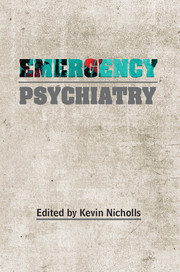Book contents
- Frontmatter
- Contents
- List of contributors
- Acknowledgements
- Preface
- 1 Assessment of suicide risk
- 2 Violence and aggression
- 3 Substance misuse emergencies
- 4 Alcohol and psychiatric emergencies
- 5 Acute psychosis
- 6 Acute side-effects of psychotropic medication
- 7 Emergencies in child and adolescent psychiatry
- 8 The psychiatric intensive care unit
- 9 Safeguarding
- 10 Emergency electroconvulsive therapy
- 11 Life-threatening medical emergencies in a mental health unit
- 12 Emergencies in intellectual disability psychiatry
- 13 Emergencies in older persons’ psychiatry
- 14 Perinatal psychiatric emergencies
- 15 Civilian and military psychological trauma
- 16 Emergencies in liaison psychiatry
- 17 Psychiatric emergencies in deaf people
- 18 Mental health law
- 19 Self-poisoning: aspects of assessment and initial care
- Index
10 - Emergency electroconvulsive therapy
Published online by Cambridge University Press: 01 January 2018
- Frontmatter
- Contents
- List of contributors
- Acknowledgements
- Preface
- 1 Assessment of suicide risk
- 2 Violence and aggression
- 3 Substance misuse emergencies
- 4 Alcohol and psychiatric emergencies
- 5 Acute psychosis
- 6 Acute side-effects of psychotropic medication
- 7 Emergencies in child and adolescent psychiatry
- 8 The psychiatric intensive care unit
- 9 Safeguarding
- 10 Emergency electroconvulsive therapy
- 11 Life-threatening medical emergencies in a mental health unit
- 12 Emergencies in intellectual disability psychiatry
- 13 Emergencies in older persons’ psychiatry
- 14 Perinatal psychiatric emergencies
- 15 Civilian and military psychological trauma
- 16 Emergencies in liaison psychiatry
- 17 Psychiatric emergencies in deaf people
- 18 Mental health law
- 19 Self-poisoning: aspects of assessment and initial care
- Index
Summary
Convulsive therapies have been used for at least 200 years, particularly for psychiatric disorder. Following the discovery that electrical stimulation can reliably induce seizures, the clinical applications were soon exploited. Techniques have improved significantly over the years and modern electroconvulsive therapy (ECT) has proved to be the most effective treatment for severe or unremitting depression, and for certain other conditions (Prudic et al, 1990, 1996; UK ECT Review Group, 2003; Dombrovski et al, 2005; Fink, 2009).
ECT is viewed with suspicion by some people and with outright hostility by others. Much of this is due to a perception that the therapy is dangerous or, more misguidedly, a form of punishment. Mainstream UK consultant psychiatrists’ opinion is that ECT is a humane, ethical and effective treatment, underpinned by a solid research base that confirms its efficacy. An authoritative review from the US National Network of Depression Centers has recently endorsed ECT as a ‘substantially underestimated’ means of ‘produc[ing] large clinical improvements for individuals suffering from severe major depressive disorders’ (Weiner et al, 2013). There is more clarity in contemporary practice around which conditions respond to ECT and how to most effectively administer the treatment, resulting in successful response rates of up to 90% in severe depression (Abrams, 2002).
History
The Romans used current generated by electric eels for the treatment of headaches and gout and to assist in obstetric procedures. Coin-operated, non-seizure-inducing, electrical stimulation of the head was common in late Victorian chemist shops and advocated for a wide range of ailments, including ‘nervous debility’. But ECT benefits are, crucially, a f unction of the seizures involved, not electric current per se. The first description of the therapeutic effect of convulsions on psychiatric disorders has been credited to Paracelsus in the 16th century, and in 1785 the therapeutic use of drug-induced seizures was described in the London Medical Journal (Abrams, 2002). A Viennese textbook of 1798 described the treatment of mania by camphor-induced seizures by Weickhardt of the Imperial Russian College (Mowbray, 1959).
Chemically induced convulsive treatment was re-invented in the 1930s by Ladislaus Meduna. Camphor was initally used to produce seizures, but was quickly superseded by more potent pro-convulsive drugs (such as pentylenetetrazol), favoured for their solubility and consequentially rapid seizure induction.
- Type
- Chapter
- Information
- Emergency Psychiatry , pp. 166 - 184Publisher: Royal College of PsychiatristsPrint publication year: 2015

